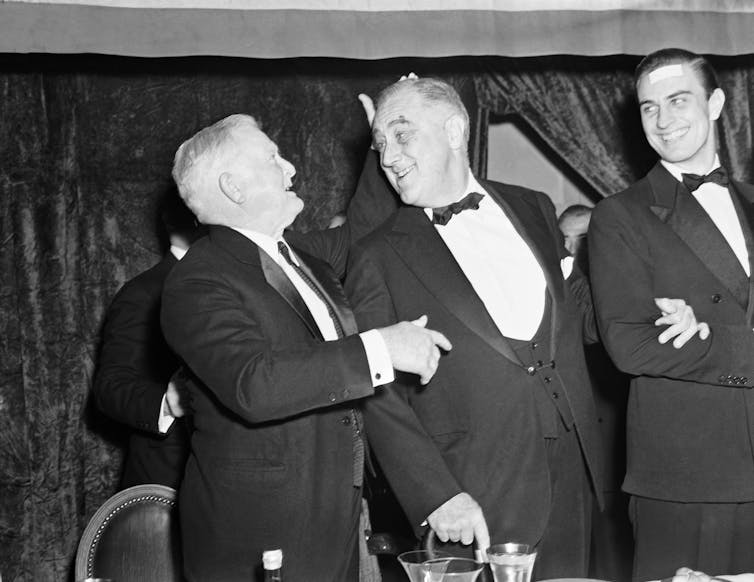Measuring a president's first 100 days goes back to the New Deal
Since the Roosevelt administration, it's become standard to look for accomplishments in a presidency's early months.

During Joe Biden’s first 100 days in office as president, he has signed 11 bills into law.
One was the prominent American Rescue Plan Act of 2021, intended to provide broad economic relief and increase distribution of COVID-19 vaccines. Another law, not so broad, added sesame to the list of allergens for food labeling requirements. A third allows U.S. senators and Senate committees to share employees.
Most of the remaining new federal laws this year relate to other pandemic relief measures or to public health issues.
President Biden’s other policy proposals are running into the roadblock known as the United States Senate, which may explain why he’s also signed 60 executive actions that don’t require the cooperation of Congress. Many of these reversed the policies of his predecessor.
But where did the tradition of using a president’s first 100 days to evaluate him originate?
Creating the concept

The idea began in 1933 with Franklin D. Roosevelt. FDR didn’t plan to put himself under scrutiny. Rather, he had in mind measuring the New Deal achievements of the first 100 days of a special congressional session that year.
In a July 24 Fireside Chat, FDR referred to “the crowding events of the 100 days which had been devoted to the starting of the wheels of the New Deal.”
In the decades since, journalists, historians and political scientists continued the practice of looking for accomplishments in the early months of a presidency.
During those 100 days, FDR got many major bills through Congress to battle the economic crisis of the Great Depression. These bills created the Public Works Administration and the Civilian Conservation Corps to provide job opportunities, the Federal Deposit Insurance Corp. to insure bank deposits and the Tennessee Valley Authority to provide rural electricity. This flurry of activity became the standard by which future presidents would be judged. Most came up short.
In a 2001 study, political scientists John Frendreis, Raymond Tatalovich and Jon Schaff determined that the presidents who followed FDR have not come close to his success levels in seeing proposed bills pass into law so early in their administrations. The authors attributed that to changes in Congress that have slowed down the lawmaking process.
Let’s consider how the presidents have done.
Truman to Clinton
Following FDR’s death, Harry Truman’s first 100 days were focused on the closing battles of World War II, with Germany’s surrender occurring less than one month after Truman took office.
Dwight Eisenhower’s first 100 days were similarly dominated by foreign policy, including the death of Soviet Union leader Joseph Stalin and negotiations to end the Korean War.
John Kennedy entered office with an ambitious agenda, which included the creation of the Peace Corps, but his first 100 days are probably best remembered for the disastrous Bay of Pigs invasion of Cuba.
Lyndon Johnson’s first 100 days were largely consumed by coping with the aftermath of Kennedy’s assassination, but LBJ also used the period and Kennedy’s legacy to begin the groundwork to pass major civil rights and war on poverty legislation.
While Richard Nixon also promoted an ambitious domestic agenda in the White House, his first 100 days contained no major achievements. Nixon told reporters: “I don’t count either the days or the hours, and I have never really thought in terms of 100 days. I plan for the long term.” Later, it was revealed that he had ordered a secret bombing of Cambodia during the period.
Gerald Ford’s first 100 days are best remembered for his swearing-in ceremony following Nixon’s resignation, when he announced that “our long national nightmare is over.” He pardoned Nixon one month later for any crimes the former president had committed in office.
Jimmy Carter also had an inauspicious start. Possibly because of his inexperience in Washington, he asked Congress to pursue several different domestic policy goals, many of which never passed into law. Perhaps best remembered from Carter’s early months is his speech from the White House to declare that energy policy and efforts to end American dependence on oil were the “moral equivalent of war.”
Ronald Reagan’s administration drew the lesson from his immediate predecessor that it was best to focus on one or two domestic issues during the first 100 days. Reagan spent his first months as president promoting an agenda of tax and spending cuts, though those did not pass into law until August 1981, four months later. Reagan’s first 100 days as president were also notable for the assassination attempt made against him, which limited his political efforts for part of the period.
George H.W. Bush’s first 100 days as president were largely a continuation of the policies of the Reagan presidency. They were noted at the time for being relatively uneventful, with a congressional battle over a secretary of defense nominee and the Exxon Valdez oil spill in Alaska dominating the political news.
The biggest political news story during Bill Clinton’s first 100 days was probably the failure of his stimulus package of domestic spending increases to get past a Republican filibuster in the Senate, though the eventual budget that resulted helped steer the United States toward budget surpluses later in the decade. Clinton’s first month also included his signing of the Family and Medical Leave Act into law, the start of a debate about service of gays in the military and the creation of a task force on national health care reform, chaired by Hillary Clinton.
The 21st century
George W. Bush took office in January 2001 after a disputed electoral outcome in Florida led to a 5-4 Supreme Court decision that essentially made him president. In a politically divided country, Bush’s strategy seemed to be to avoid controversy and build his political capital, with his major legislative proposals in the time period involving tax cuts and education reform.
Because of the economic crisis that began during Bush’s final months as president, Barack Obama’s first 100 days in office were dominated by the passage of the American Recovery and Reinvestment Act, a package of economic stimulus investments that by some measures was even larger than those passed in FDR’s 100 days in 1933. During a CBS “60 Minutes” interview in November 2008, Obama even said he was reading about FDR’s 100 days as an example.
During Donald Trump’s first 100 days in office, his main political success was the confirmation of Neil Gorsuch to the Supreme Court. Trump’s first 100 days also featured government malfunction. Massive protests greeted his attempts to ban entry of citizens of certain Islamic countries into the U.S. and suspend refugee entry, and federal judges blocked the bans. Trump’s promised repeal and replacement of the Affordable Care Act failed.
[The Conversation’s Politics + Society editors pick need-to-know stories. Sign up for Politics Weekly.]
Biden already has one significant legislative achievement during his first 100 days, the American Rescue Plan Act. He also used his powers as president to expedite COVID-19 vaccine distribution, rejoin the Paris Agreement on climate change, and revoke some of Trump’s border measures and the permit for the Keystone XL pipeline. Among the dilemmas he has faced is a large number of children seeking asylum in the United States at the Mexican border.
Biden has proposed a sweeping infrastructure plan, new climate change policies, immigration reforms and criminal justice and police reforms, among other campaign promises he wants to fulfill. Whereas FDR in the 1930s could count on Democratic majorities in Congress to vote many of the president’s proposed ideas into law, Biden has been unable to accomplish the same so far.
The current tiny Democratic majorities in the House and Senate in Washington, and a Senate filibuster now used to stop almost all significant legislation, have prevented Biden from being able to match FDR’s level of accomplishments during his first 100 days.
If Biden would like during his first year as president to match an FDR level of presidential achievement, it will likely be necessary to negotiate deals with at least 10 Senate Republicans. Or Biden will need to persuade a group of very reluctant Senate Democrats to abandon the filibuster power once and for all.
This is an updated version of an article originally published on April 17, 2017.
Robert Speel does not work for, consult, own shares in or receive funding from any company or organisation that would benefit from this article, and has disclosed no relevant affiliations beyond their academic appointment.
Read These Next
The North Pole keeps moving – here’s how that affects Santa’s holiday travel and yours
There are actually two North Poles. One has been wandering over northern Canada and north of there for…
2 superpowers, 1 playbook: Why Chinese and US bureaucrats think and act alike
The men and women tasked with implementing policy are governed by the same incentives and constraints…
How rogue nations are capitalizing on gaps in crypto regulation to finance weapons programs
North Korea was behind a $1.5 billion digital bank heist in February 2025. Other countries are similarly…





